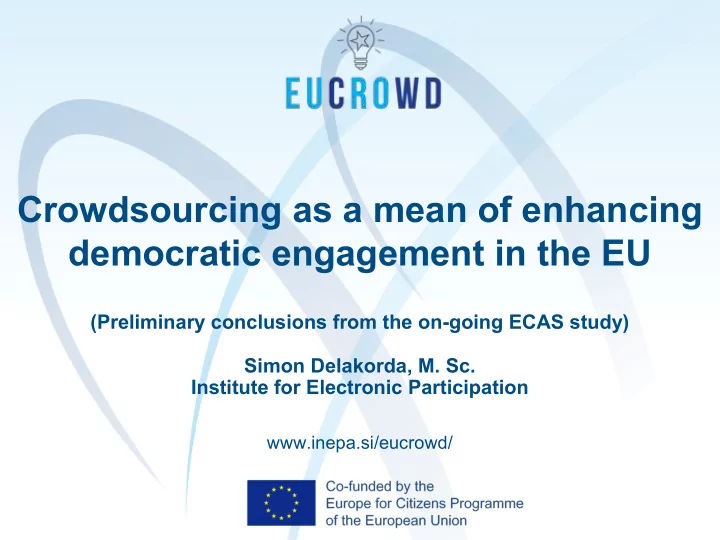

Crowdsourcing as a mean of enhancing democratic engagement in the EU (Preliminary conclusions from the on-going ECAS study) Simon Delakorda, M. Sc. Institute for Electronic Participation www.inepa.si/eucrowd/
Table of Content 1 Starting point 2 Issues with citizen participation in the EU 3 Crowdsourcing study 4 Methodological framework 5 List of crowdsourcing cases 6 France: Participatory Budgeting in Paris 7 Australia: Future Melbourne 8 Slovenia: Predlagam vladi.si 9 Preliminary considerations 10 Project European Citizens Crowdsourcing (EUCROWD)
1 Starting point Existing forums for citizen participation in the EU have proven ineffective in bridging the democratic deficit. The crises the EU is currently facing call for more innovative forms of citizen engagement in order to re-gain their trust in the European project (1). (1) European Citizen Action Service (2016): Towards a Crowdsourcing Pilot at the EU level: Taking Decisions with Citizens and Not for Them (Working Paper). Available from http://ecas.org/read-new-paper-crowdsourcing/.
2 Issues with citizen participation in the EU Vir: EVROBAROMETER 86.1
41% of EU citizens want to influence decision-making directly. Up to 80% of the legislation concerning the everyday life of citizens in Member States may be based on EU laws. This general feeling of distrust that translates into concrete manifestations of anti-EU political rhetoric and strategic choices with serious consequences for the future of the European project (e.g. Brexit). Problems of participatory democracy at the EU level.
Vir: http://ec.europa.eu/citizens-initiative/public/welcome?lg=sl
Vir: http://ec.europa.eu/yourvoice/consultations/index_sl.htm
Vir: https://petiport.secure.europarl.europa.eu//petitions/sl/main
3 Crowdsourcing study The crowdsourcing allows people to participate in a constructive way in debates and to learn from each other throughout the deliberation process (“Wisdom of the crowd” principle). Crowdsourcing legislation is “an open call for anybody to participate in a task open on-line (Brabham, 2008; Howe, 2008) by submitting information, knowledge, or talent. Crowdsourcing has become a popular tool to engage people in processes ranging from urban planning (Brabham, 2010) to new product design and solving complex scientific problems (Aitamurto, Leiponen & Tee, 2011)”. Vir: http://www.inepa.si/eucrowd/project/
4 Methodological framework Desk research and consultation with relevant stakeholders to identify national crowdsourcing examples; Definition of criteria for the analysis of the national examples; National crowdsourcing experience analysis; ‘Theory of Change’ elaboration; Development of a framework for piloting crowdsourcing legislation at EU level and on an EU issue; Identification of questions which need further exploration and/or verification. Vir: http://ecas.org/read-new-paper-crowdsourcing
The strengths and weaknesses of the crowdsourcing initiatives were measured by ECAS using the following set of objectives: Vir: http://ecas.org/read-new-paper-crowdsourcing
5 List of crowdsourcing cases 1. New Zealand: Internet Rights Bill 2. Philippines: Crowdsourcing Act 2012 3. Philippines: Magna Carta for Internet Freedom 4. Netherlands: Follow the Law 5. Finland: National Citizens Initiatives 6. France: Participatory Budgeting in Paris 7. Iceland: Crowdsourced Constitutional Reform 8. Argentina: Democracy OS 9. Australia: Future Melbourne 10. India: MyGov 11. Belo Horizonte, Brazil: Digital Participatory Budgeting 12. Estonia: Democratic Proposals 13. Finland: Road Traffic Rules 14. New Zealand: New Flag 15. Belgium: Crowdfunding Gent 16. Slovenia: I suggest to the Government? 17. Latvia: Open Government 18. Germany: Maerker Brandenburg 19. Germany: Essen-soll-leiser-werden 20. U.S.: Challenge.gov 21. U.S.: We, The People. 22. California: Probate legislation 23. Boston: Youth Participatory Budgeting 24. Mexico: Crowdsourcing Constitution 25. Austria: Digital Agenda Vienna 26. United Kingdom: Open Government Manifesto 27. United Kingdom: You Decide – Participatory Budgeting
6 France: Participatory Budgeting in Paris Vir: https://budgetparticipatif.paris.fr/bp/
7 Australia: Future Melbourne Vir: http://participate.melbourne.vic.gov.au/future
8 Predlagam vladi.si Vir: http://predlagam.vladi.si/
9 Preliminary considerations Crowdsourcing must be used as a complementary method to other online/offline participation tools, which would ensure greater representativeness. Participants’ contributions were of a higher quality, more focused and easier to adopt when the government was in control of the central repository, mainly in terms of who could access it (e.g. registered citizens). Crowdsourcing projects must have solid systems in place, for example to effectively verify that those responding are within the intended group (e.g. actual citizens and not anonymous fake accounts) and to ensure that spam contributions are removed. Crowdsourcing projects can increase the legitimacy of policy- making mainly when the ideas generated are actually implemented (if not, they could backfire). Vir: http://ecas.org/read-new-paper-crowdsourcing
10 Project European Citizens Crowdsourcing (EUCROWD) Project time frame: 1 September 2016 – 28 February 2018 Project budget: 147.750 EUR Europe for Citizens Programme 2016
Source: http://www.inepa.si/eucrowd/
Vir: https://twitter.com/Razprave_EU
Source: www.facebook.com/evropske.razprave/
Questions & Answers
THANK YOU! simon.delakorda@inepa.si www.inepa.si facebook.com/institut.inepa twitter.com/Institut_INePA si.linkedin.com/in/simondelakorda
Recommend
More recommend